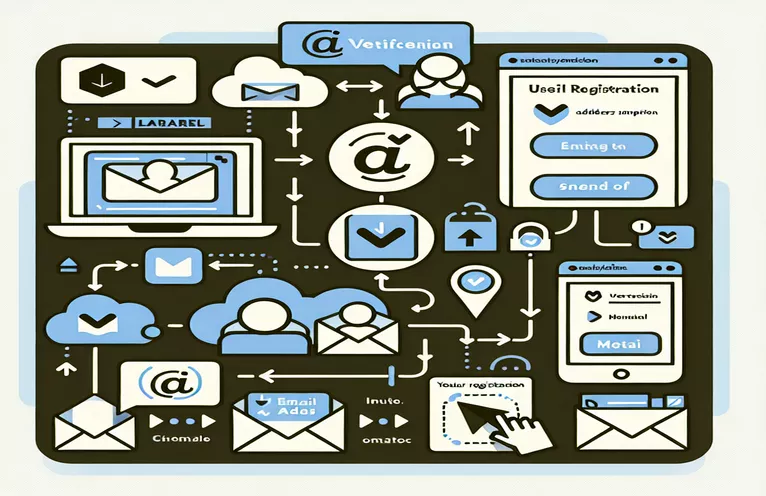Email Verification in a Multi-Tenant Application
This tutorial will walk you through the process of adding email verification to a Laravel multi-tenant application using a Nuxt.js frontend. Ensuring appropriate email verification is essential to preserving data integrity and user security.
We'll go over how to set up your Laravel backend for multi-tenancy, send user registration verification emails, and manage the verification process with ease. You may successfully manage email verification in your multi-tenant architecture by following this advice.
| Command | Description |
|---|---|
| Tenant::create() | Enables the creation of a new tenant instance for multi-tenant applications with the given name. |
| Artisan::call() | Programmatically executes Artisan commands, which are utilized to seed the database in the tenant context. |
| event(new Registered($user)) | Causes the newly formed user to receive a verification email by way of the Registered event. |
| $tenant->run() | Isolates tenant-specific actions by executing a callback function inside the tenant's database connection. |
| $tenant->domains()->create() | In order to enable domain-based tenant identification, associates a new domain with the newly established tenant. |
| hash_equals() | Utilizes a timing-attack-safe comparison of two hashes to confirm email verification tokens. |
| User::markEmailAsVerified() | Changes the relevant database column and marks the user's email as validated. |
| app(VerifyEmailResponse::class) | Provides a response that is used in the email verification process to indicate the status of the email verification. |
| AuthorizationException | Thrown in order to make sure that only legitimate requests for email verification are handled when a permission check fails. |
Email Verification Flow Explanation
The first script walks through the process of managing user registration in a Nuxt.js-integrated multi-tenant Laravel application. Using the Tenant::create() command, a new tenant is established upon user registration. The Artisan::call() command is used to seed the database with initial data within the tenant context. After that, a new user is formed, and an email verification is sent out in response to the event(new Registered($user)) instruction. Through this procedure, data integrity and separation are maintained and each tenant is guaranteed to operate independently.
The process of email verification is managed by the second script. Upon clicking the verification link, the user is retrieved by ID using the User::findOrFail($request->route('id')) command. To ensure security, the email verification hash is verified using hash_equals(). The user's email is tagged as confirmed with User::markEmailAsVerified() if the hash matches, and any further commands are triggered by the event(new Verified($user)) command. This script offers a smooth verification process by not requiring the user to be logged in.
Using Nuxt.js to Implement Email Verification in Laravel for Multi-Tenant Applications
Laravel Backend Code for Email Verification and User Registration
<?phpnamespace App\Http\Controllers;use App\Models\User;use App\Models\Tenant;use Illuminate\Http\Request;use Illuminate\Support\Facades\Artisan;use Illuminate\Support\Facades\Hash;use Illuminate\Auth\Events\Registered;class AuthController extends Controller {public function register(Request $request) {$tenant = Tenant::create(['name' => $request->first_name . ' Team']);$tenant->run(function () use ($request) {Artisan::call('db:seed', ['--class' => 'DatabaseSeeder']);$user = User::create(['first_name' => $request->first_name,'last_name' => $request->last_name,'email' => $request->email,'password' => Hash::make($request->password),'phone_number' => $request->phone_number,]);event(new Registered($user));});$tenant->domains()->create(['domain' => $request->domain_name]);return response()->json(['message' => 'Successfully created - Check your email to verify!']);}}
Processing Email Verification Without Needing to Login
Using Laravel Controller to Verify Emails
<?phpnamespace App\Http\Controllers;use App\Models\User;use Illuminate\Http\Request;use Illuminate\Auth\Events\Verified;use Illuminate\Auth\Access\AuthorizationException;use Laravel\Fortify\Contracts\VerifyEmailResponse;class VerifyEmailController extends Controller {public function __invoke(Request $request) {$user = User::findOrFail($request->route('id'));if (!hash_equals(sha1($user->getEmailForVerification()), (string) $request->route('hash'))) {throw new AuthorizationException;}if ($user->hasVerifiedEmail()) {return app(VerifyEmailResponse::class);}if ($user->markEmailAsVerified()) {event(new Verified($user));}return app(VerifyEmailResponse::class);}}
Verification of Email Without User Login
Making sure that email verification functions properly without requiring the user to be signed in is a crucial component of email verification in a multi-tenant Laravel application. To get around the login requirement, the verification flow can be customized. When a user clicks on the email verification link, the program checks the unique hash it includes to make sure the request is authentic.
You can manage the verification logic without requiring user authentication by developing a new controller, like the VerifyEmailController, to handle email verification. By enabling users to confirm their email address straight from the email link, this method improves user experience and guarantees a more streamlined and intuitive process.
Common Queries Regarding Email Verification in Laravel Applications for Multiple Tenants
- In Laravel, how can I add a new tenant?
- A new tenant can be created with the Tenant::create() command.
- Why is the database being seeded when a tenant is created?
- Tenant-specific data is initialized in the database by seeding it with Artisan::call('db:seed').
- The email verification event is initiated in what way?
- The command event(new Registered($user)) is utilized to initiate the email verification event.
- Why verify emails using hash_equals()?
- To compare verification tokens in a secure manner, use the hash_equals() command.
- Does email verification require a user login to function?
- Yes, by using a controller like VerifyEmailController to modify the verification flow.
- How can an email be marked as verified?
- To update the status of the verification, use the User::markEmailAsVerified() command.
- What does place when an email is confirmed?
- Using event(new Verified($user)), an event is set off for further actions.
- How should I respond to verification errors?
- Discard a AuthorizationException to handle erroneous verification tries.
- Does every renter need to have their own domain?
- Yes, tenant identification is aided by a domain's association with $tenant->domains()->create().
Concluding Email Verification for Applications with Multiple Tenants
Ensuring user security and data integrity in a multi-tenant Laravel application with a Nuxt.js frontend requires the implementation of email verification. You can make sure that the verification process goes well by using Laravel's built-in features and building new controllers. This method improves the user experience by enabling users to verify their accounts straight from the verification link without having to log in. You can efficiently handle email verification in your multi-tenant application by following the guidelines and sample data, guaranteeing a stable and secure solution.


